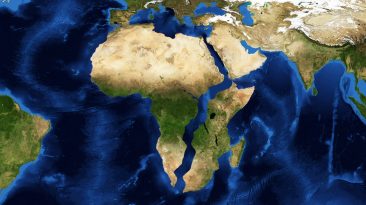Our planet has seen this before. Its ice has already melted. Water levels have risen. Ocean currents have already stopped.
The last time this happened was 13,000 years ago. Humans didn’t study climate back then.
Now, everything is coming full-circle. And we should be concerned. If all those events were to happen again today, you wouldn’t recognize the Earth you’re living in.
How would the melting ice change the world? Why would ocean currents throw us into a new Ice Age?
Ocean currents dictate the Earth’s climate. They push hot equatorial waters toward the poles and return cold polar waters to the equator.
In the northern hemisphere, it’s the Gulf Stream getting the job done. Moving water at roughly 2 m/s (6.5 ft/s), the Gulf Stream is one of the largest and fastest currents in the ocean.
It carries warm seawater all the way from the Gulf of Mexico to the eastern coastlines of the U.S. and Newfoundland, then across the Atlantic ocean, where it splits in two – crossing to Northern Europe and recirculating off West Africa. The Gulf Stream is a part of the global ocean conveyor belt.
What does ice have to do with all this?
Currents circulating through the oceans don’t just appear out of nowhere. They’re created out of differences in water density.
Warm water has a lower density and rises to the surface. Cold water has a higher density and therefore it sinks to the bottom.
But there’s one more thing that determines the density of water – the amount of salt in it. And that’s where the ice caps enter the game.
Polar ice is composed of fresh water. As it melts, it adds more fresh water into the sea making the water in the North Atlantic less dense. At some point, it won’t be able to sink anymore. The global ocean conveyor belt will stop circulating.
This would be the end of the Gulf Stream and the beginning of something else. A new Ice Age. You heard it right. We may be heating up the planet year by year, but climate isn’t that simple.
The Gulf Stream is a warm current. It’s what makes winters on the west coast of Europe so mild. It also keeps winter temperatures warmer and summer temperatures cooler on Florida’s east coast.
What would happen if this warmth-bearing current was cut off? Well, it would stop bringing warm waters to those areas.
Western Europe would get plunged into a deep freeze. And so would North America. The average temperature of Europe would drop by up to 10 °C (18°F).
Ice storms would rampage through Spain, France, Portugal and the UK. London, among other cities, would be covered in snow for weeks. Something is telling me, Londoners would never stop complaining about the weather.
The east coast of the U.S. would have a different problem – rising water levels. Normally, sea levels on the U.S. coast are lower compared to those on the coasts of Europe. That’s because the Gulf Stream is warmer when it gets to Europe. Take the Gulf Stream out of the equation, and the water would push back toward the U.S.
In the long term, that would disrupt agriculture in those areas, drowning the economies that rely on growing and distributing crops. And while the east coast of America and Western Europe get chilly in their local Ice Age, temperatures in the rest of the world would keep rising.
Climate change would trigger fires, tsunamis, hurricanes – all at the same time. That would be a different world. Nothing that the Earth hasn’t seen before. Except this time, civilization would be disrupted, and be left to deal with the changing climate when the ocean currents decide to take a break.
Subscribe to What-If on YouTube or follow the show on Facebook Watch.
Sources
- “A Chilling Possibility | Science Mission Directorate”. 2019. science.nasa.gov. Accessed March 24 2019.
- “What Causes Ocean Currents?”. 2019. oceanexplorer.noaa.gov. Accessed March 24 2019.
- “Arctic Sea-Ice Decline Weakens The Atlantic Meridional Overturning Circulation”. Sévellec, Florian, Alexey V. Fedorov, and Wei Liu. 2017. Nature Climate Change 7 (8): 604-610. Springer Nature. doi:10.1038/nclimate3353.
- “Melting Arctic Sea Ice And The Global Ocean Conveyor – Windows To The Universe”. 2019. windows2universe.org. Accessed March 24 2019.
- “The thermohaline circulation” 2019. cru.uea.ac.uk. Accessed March 24 2019.
- “Extreme Sea Level Rise Event Linked To AMOC Downturn | US CLIVAR”. 2015. Usclivar.Org. Accessed March 24 2019.
- “What Is The Global Ocean Conveyor Belt?”. 2019. oceanservice.noaa.gov. Accessed March 24 2019.
- “NOAA’s National Ocean Service Education: Currents“. 2019. oceanservice.noaa.gov. Accessed March 24 2019.



























